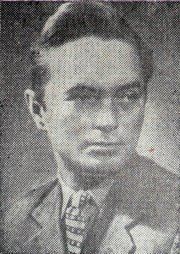Nationality Soviet Ukrainian Died 1975, Moscow, Russia Role Author | Name Anatoly Dneprov Occupation Author | |
 | ||
Born November 17, 1919 Dnipropetrovsk | ||
Anatoly dneprov radovat mpg
Anatoly Dneprov also spelled Anatoly Dnieprov (Ukrainian: Анатолій Дніпров; pseudonym, real name Anatoliy Petrovych Mitskevitch) (November 17, 1919 in Dnipropetrovsk – 1975 in Moscow) was a Soviet author of Ukrainian descend, whose science fiction stories were published in the United States from 1961-1970. He is best known for his stories The Maxwell Equations (1963) and Iva.
Contents
Career
Anatoly Dneprov was a physicist who worked at an institute of the U.S.S.R. Academy of Sciences. The Progress Publishers, Moscow wrote about him: His favourite subject is cybernetics – its amazing achievements to date and its breath-taking potentialities. Scientific authenticity is a salient feature of his writings.
Today he is almost a forgotten writer, but his predictions about artificial intelligence and self-replicating machines are uncanny.
Selected works
"All the sensations that go to make up your spiritual ego are nothing but electrochemical impulses that travel from receptors up to the brain to be processed, and then down to effectors."
'This is where the information is convolved into the model of the object.
These thin air-cooled needles are something like those used for intermuscular injections. A thin stream of plastic material is pressed through them in short spurts. The needles are synchronized with the ultra-sound needles which are at this moment feeling around the real object. Drop by drop, from point to point, the thin stream of plastic builds the model. The scale of the model may be regulated by using these levers. They may be made larger or smaller than the real object...'
'What about the colour?'
'That's easy. In the initial state the material is colourless, but the photocalorimeter, according to the colour information received, introduces the necessary amounts of the dyes indicated...'
"Why not? Any machine tool, a lathe, for example, makes parts for
lathes like itself. So I conceived the notion of making an automatic machine that would manufacture copies of itself from start to finish. My crab is the model of such a machine."
